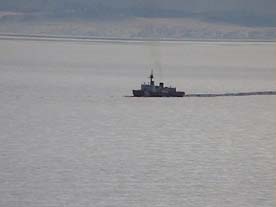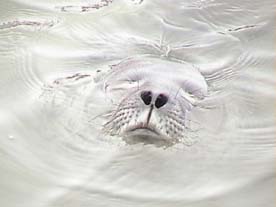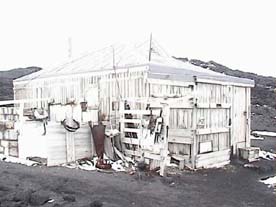 Teacher Feature...
Teacher Feature...
Greetings from Ross Island!
by LT Marshall Branch
We have now been at McMurdo Station for 2 weeks and we have really enjoyed flying in this incredible environment. So far, I have flown to Black Island, Cape Royds on Ross Island, the Dry Valleys on the mainland, and Marble Point. At Cape Royds, there is a penguin rookery being studied by Mr. David Ainley, a scientist who has spent over 20 years studying Arctic and Antarctic biology. He took me down to see the penguins and told me what to look for.

Penguin mom feeding chick at Cape Royds
Click the image for a larger view.
Because of the 2 major icebergs in the Ross Sea (B-15 lodged up against Beaufort and Franklin Islands and C-19 floating north of McMurdo Sound), the sea ice that usually drifts out of McMurdo Sound and melts harmlessly in the Southern Ocean has been pinned in to the area. That is one of the reasons why the solid ice sheet (see the picture below of the POLAR SEA breaking through the solid ice) extends all the way out to 48 miles from McMurdo instead of only 10-15 miles. This means the penguins have to travel 10-15 miles across solid ice to find open water in which to hunt for food. As a result, only 400 nests at Cape Royds have chicks (as opposed to 4,000 chicks from years prior). Not to be alarmed though, this is the natural cycle of this unforgiving ecology. There have been many years throughout history in which heavy ice conditions hampered the penguins abilities to nest. The population will take several years to recover, but they always seem to eventually come back.

Polar Sea making first channel cut
Click the image for a larger view.
Another interesting animal we saw was a Weddell Seal that came right up to us at the pier where the POLAR SEA was going to tie for refueling. The ship had to stop and wait for about 15 minutes while personnel attempted to herd it out of the way of the 400-foot ship. As you probably guessed, the seal decided it would probably not win in a game of chicken with a 75,000 horse powered Icebreaker and departed the area. We got some great pictures of it before it left.

Weddell Seal Close-up
Click the image for a larger view.
Finally, I have had the unique opportunity to explore some of the "Huts" of the great Antarctic explorers. Robert Falcon Scott and Ernest Shackelton were two of the great explorers of the region. They established prefabricated shelters at various locations where they could cache food and supplies, or find shelter to ride out the terrific Antarctic storms. Because of the extremely dry climate and cold temperatures, everything in these huts, including clothes, food, and even seal carcasses harvested in the early 1900's are still in their original condition. It was fascinating to walk through these shelters with everything frozen in time. The stories of these explorers are amazing as well. Did you know that Shackelton and his men survived for 2 years on the ice in McMurdo Sound after losing their ship?

Shackelton's Hut - Cape Royds
Click the image for a larger view.
I hope that you enjoy the pictures and I encourage you to learn about the trials of the explorers that first set foot on this harsh continent and the animals that live here. Take care!
Your Coastie,
Marshall
For more information see...
http://www.polar.org/antsun/Sun011903/index.html
Questions to the Sun for the 2002-03 season
Operation Deep Freeze Gazette Articles:
Browse the latest posts from the High School Chatboard:
| 
